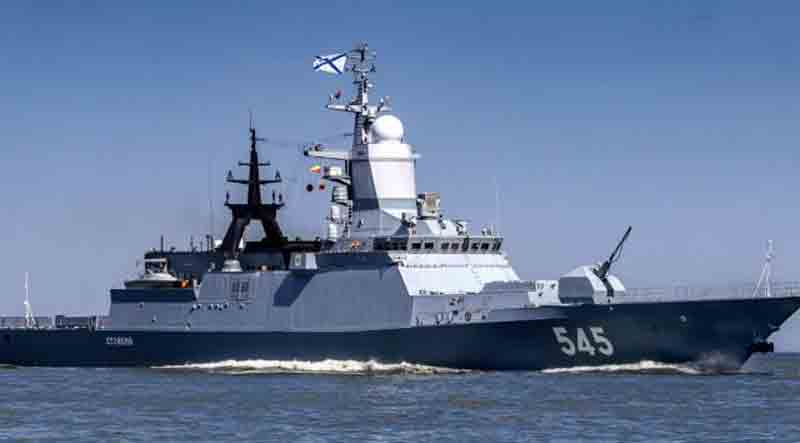The Russian Navy’s corvette Stoyki, part of the Steregushchiy class, recently undertook a series of advanced military drills in the Baltic Sea, demonstrating its sophisticated combat capabilities. During a scheduled training mission, the crew performed electronic missile launches utilizing the Uran anti-ship missile system and engaged in simulated attacks on both aerial and naval targets using air defense and artillery systems.
These exercises, conducted in one of Europe’s most strategically critical maritime areas, encompassed a wide range of operations—from countering hypothetical enemy vessels to addressing aerial threats and executing electronic warfare strategies.
The Russian Ministry of Defense reported that all training objectives were successfully achieved, with the Stoyki’s crew effectively “destroying” assigned targets in a controlled environment. Although a specific date for the exercises was not disclosed, they are part of Moscow’s ongoing strategy to sustain a strong naval presence amid escalating tensions with NATO in the Baltic region.
During the operation, the Stoyki’s missile and artillery teams employed the Uran system, recognized for its accuracy against surface ships, to simulate attacks on a fleet of enemy vessels. The crew also addressed air defense scenarios, successfully neutralizing incoming aerial threats through a combination of artillery and anti-aircraft systems as the simulated targets entered the ship’s engagement zone.
In addition to combat training, the exercises included electronic warfare tactics, such as jamming, as well as drills focused on ship survivability, navigation through narrow passages, and countermeasures against underwater and sabotage threats.
A statement from the Baltic Fleet’s press office, as reported by the Russian Ministry of Defense, characterized the exercise as a thorough evaluation of the corvette’s multifunctional capabilities, highlighting its importance in maintaining maritime security.
The Stoyki is well-acquainted with the Baltic Sea, a maritime area surrounded by NATO countries such as Estonia, Latvia, Lithuania, and the recently added members Finland and Sweden. This latest military exercise occurs amid increased military activities from both Russian and Western forces in the region, highlighting ongoing geopolitical tensions.
Experts believe that these drills serve various functions, including assessing operational readiness, enhancing crew proficiency, and conveying a message of deterrence. Dr. Michael Petersen, a naval specialist at the U.S. Naval War College, remarked, “The Baltic Sea is a contested space.”
“Russia conducts these exercises to demonstrate its capability to project power near NATO’s borders, particularly as the alliance expands its presence.” The timing and location of the exercise add to its importance, although Moscow has not directly linked it to any particular event.
The Steregushchiy-class corvettes, designed by the Almaz Central Marine Design Bureau, signify a modern advancement in Russia’s naval strength. The Stoyki, with hull number 545, was constructed at the Severnaya Verf shipyard in St. Petersburg, with its keel laid on November 27, 2006. It was launched on May 30, 2012, and officially joined the Baltic Fleet upon commissioning on May 18, 2014, with a flag-raising ceremony taking place two months later on July 27.
Measuring 343 feet in length and displacing 2,200 tons when fully loaded, this vessel surpasses the dimensions of conventional corvettes, leading NATO to categorize it as a frigate. Its steel hull and composite superstructure are designed with stealth capabilities, featuring a minimized radar profile achieved through innovative hull design and radar-absorbent materials, which enhance its effectiveness in coastal waters.
The ship’s weaponry significantly contributes to its adaptability. It is equipped with the Uran missile system, which includes Kh-35 anti-ship missiles that can engage targets at distances of up to 260 kilometers, although training exercises typically utilize shorter ranges for safety and operational control.
For air defense, the Stoyki incorporates the Redut vertical launch system, which has replaced the previous Kashtan close-in weapon system on later models of this class. The Redut system is capable of launching 9M96E medium-range surface-to-air missiles, derived from the S-400 system, providing defense against aircraft, drones, and incoming missiles.
Furthermore, the corvette is armed with a 100mm A-190 deck gun for engaging surface and aerial threats, two AK-630M 30mm close-in weapon systems for point defense, and twin 330mm torpedo tubes for anti-submarine operations. It also features a hangar and deck space for a Kamov Ka-27 helicopter, which enhances its capabilities for detecting and targeting submarines or surface threats at extended ranges.
With a crew of approximately 100, the Stoyki is driven by a combined diesel-and-diesel (CODAD) propulsion system, which includes four Kolomna 16D49 engines generating 23,664 horsepower across two shafts. This configuration allows for a maximum speed of 27 knots and a cruising range of about 4,000 nautical miles at 14 knots, enabling prolonged missions in the Baltic Sea and beyond.
The design of the ship prioritizes survivability, featuring nine watertight compartments and sophisticated damage control systems, as evidenced by recent survivability drills. Its electronic warfare suite, utilized during exercises to disrupt simulated threats, enhances its physical armament, establishing it as a versatile platform for contemporary naval warfare.
The operational history of the Stoyki underscores its significant involvement in Russia’s Baltic Fleet. Since its commissioning, the vessel has engaged in a variety of exercises and deployments, frequently alongside sister ships such as Steregushchiy, Soobrazitelnyy, and Boikiy. In April 2015, it participated in a Baltic Fleet task force focused on anti-aircraft and anti-submarine operations, successfully firing artillery at both sea and aerial targets while coordinating with naval aviation units.
In November 2016, the corvette executed a successful simulated strike using the Uran system against a complex target set, which included a mock cruise missile, during exercises in the Baltic Sea. Additionally, in June 2018, it took part in an extensive deployment to the North Atlantic, traveling thousands of miles over several months alongside Boikiy, the tanker Kola, and the tug Viktor Konetsky.
The Stoyki has also contributed to Russia’s naval presence in strategically contested waters. In November 2019, it returned to its homeport in Baltiysk after completing a 30-day mission in the Baltic Sea with the landing ship Kaliningrad, during which it covered over 4,000 nautical miles. More recently, in April 2023, it was reported to have navigated from the Mediterranean to the Baltic via the Atlantic, accompanied by Soobrazitelnyy and the frigate Admiral Grigorovich.
These missions demonstrate the corvette’s resilience and versatility, attributes that were evident in its latest exercises. The vessel’s capability to address a range of threats—including surface vessels, aircraft, submarines, and electronic warfare—establishes it as a crucial component of Russia’s regional strategy.
The strategic significance of the Baltic Sea is immense. Spanning from Denmark to the Gulf of Finland, it links Russia’s Kaliningrad exclave to the mainland and functions as a critical corridor for trade and military operations. Its proximity to NATO countries further enhances its status as a geopolitical hotspot.
Since Russia’s annexation of Crimea in 2014 and the ensuing conflict in Ukraine, military operations in the area have escalated. NATO has increased its presence through exercises such as Northern Coasts and the deployment of naval vessels from the U.S., U.K., and other allied nations. In response, Russia has conducted its own military drills, including the significant Ocean-2024 exercise earlier this year, which utilized assets from the Baltic Fleet.
This backdrop explains Russia’s rationale for these exercises. In addition to ensuring crew readiness and testing equipment, these drills serve to showcase military capabilities in a region where demonstrating naval strength acts as a diplomatic tool. Katarzyna Zysk, a professor at the Norwegian Institute for Defence Studies, noted in a recent discussion that “Russia aims to make its adversaries aware of the Baltic Fleet’s active and credible presence.”
“These exercises are equally focused on deterrence as they are on preparedness.” The implementation of electronic launches—simulated firings without actual munitions—provides realistic training while reducing the risk of escalation, a sensible approach given the busy waters of the Baltic Sea.
For American audiences, Stoyki’s exercise may draw parallels to U.S. naval operations, such as those involving the Littoral Combat Ship (LCS) program, although the Steregushchiy-class vessels are more heavily armed and less modular. The U.S. Navy has been closely monitoring similar Russian activities, frequently deploying assets like the Sixth Fleet to observe movements near NATO waters.
In March 2021, a detachment from the Baltic Fleet, which included the Stoyki’s sister ship Boikiy, made an unannounced passage through the English Channel, leading to HMS Sutherland monitoring their movements. These interactions highlight the ongoing cat-and-mouse scenario, although there has been no reported direct response from the U.S. regarding this particular maneuver.
The capabilities of the Stoyki also raise concerns among its potential adversaries. The Uran system’s Kh-35 missiles, which travel at Mach 0.8 and operate at low altitudes, present a risk to smaller NATO vessels, despite their limited range and payload compared to Russia’s Kalibr missiles deployed on larger ships.
While the Redut system is considered advanced, its reliability in combat situations has been questioned, as noted in Western defense assessments, including those from the Center for Naval Analyses. Nevertheless, the Stoyki’s combination of artillery and electronic warfare systems enhances its effectiveness as a formidable adversary in confined maritime environments like the Baltic Sea.
Looking to the future, the Steregushchiy-class fleet is expected to expand. The Russian Navy intends to acquire a minimum of 30 of these vessels across its four primary fleets, with additional ships currently being constructed at Severnaya Verf and the Amur Shipyard. The Stoyki may also receive upgrades, as reports indicate that its lead ship, Steregushchiy, is scheduled for a refit to incorporate Kalibr-NK cruise missiles.
Currently, the Stoyki’s operations are focused on the Baltic Sea, where it continues to conduct patrols and training exercises. The most recent drills, which emphasized multi-domain operations, reinforce this mission, keeping the corvette—and Russia’s naval aspirations—at the forefront of attention for observers across the Atlantic.
Discover more from Defence Talks | Defense News Hub, Military Updates, Security Insights
Subscribe to get the latest posts sent to your email.





